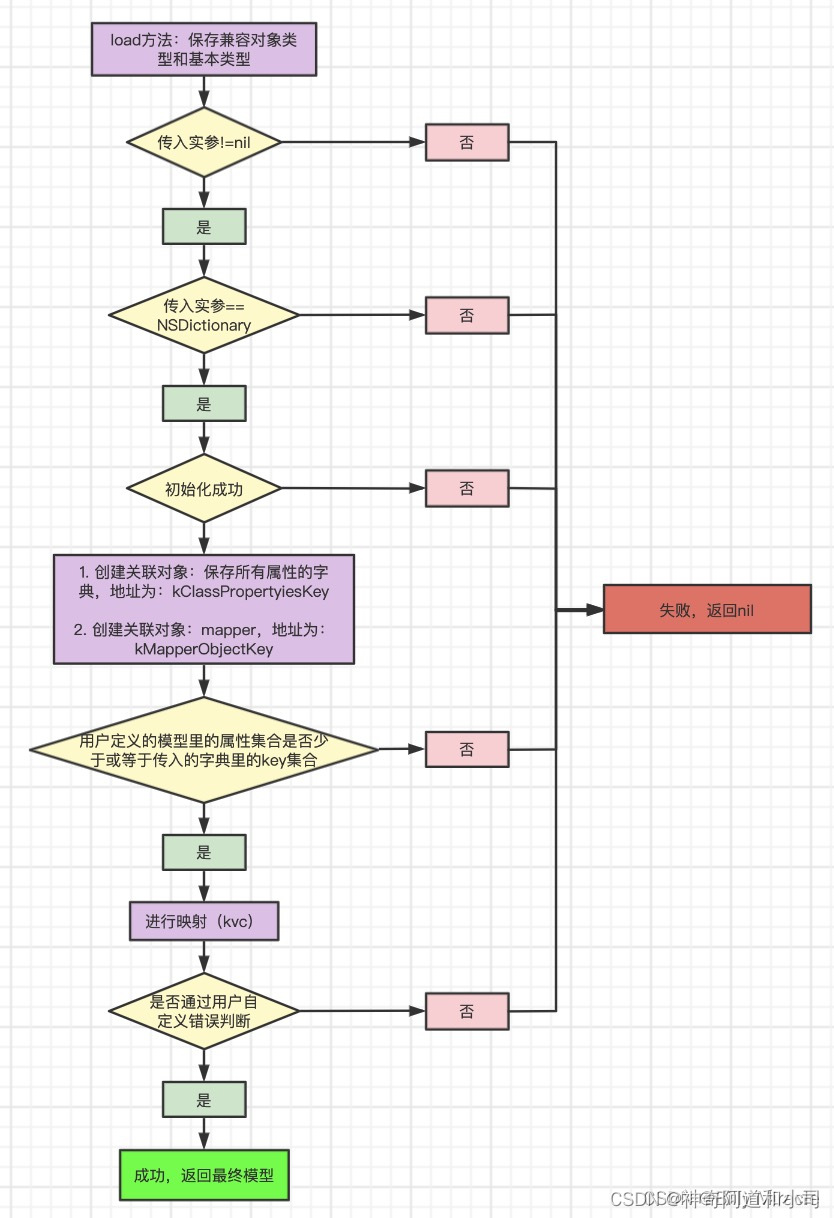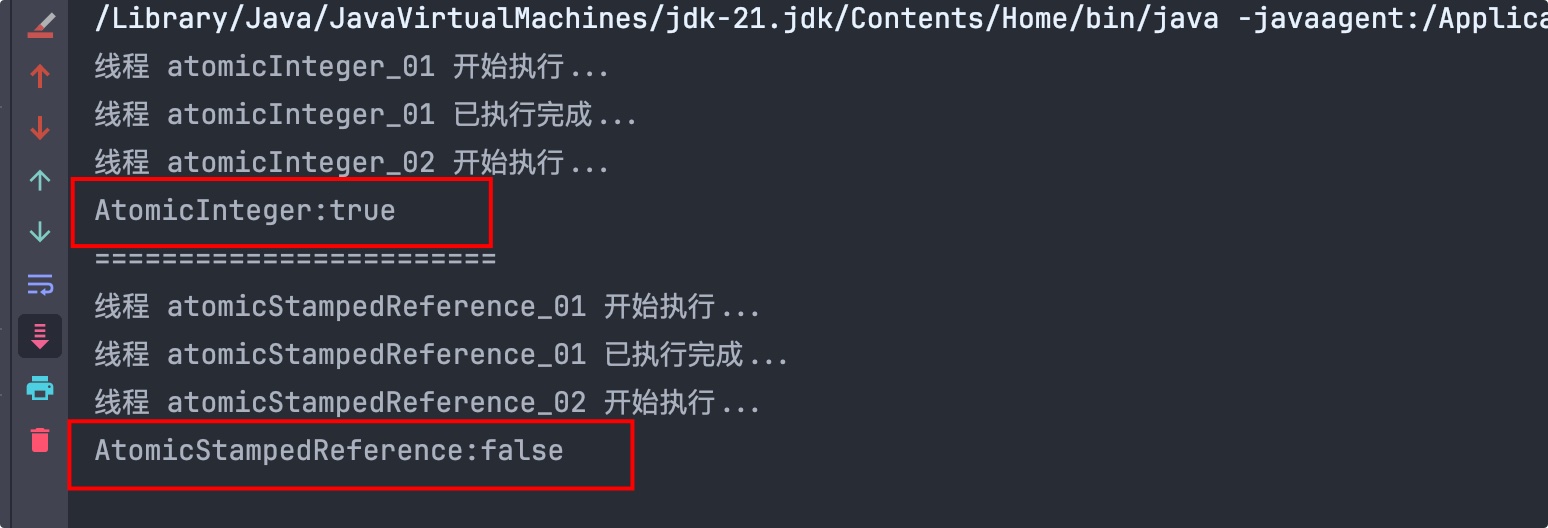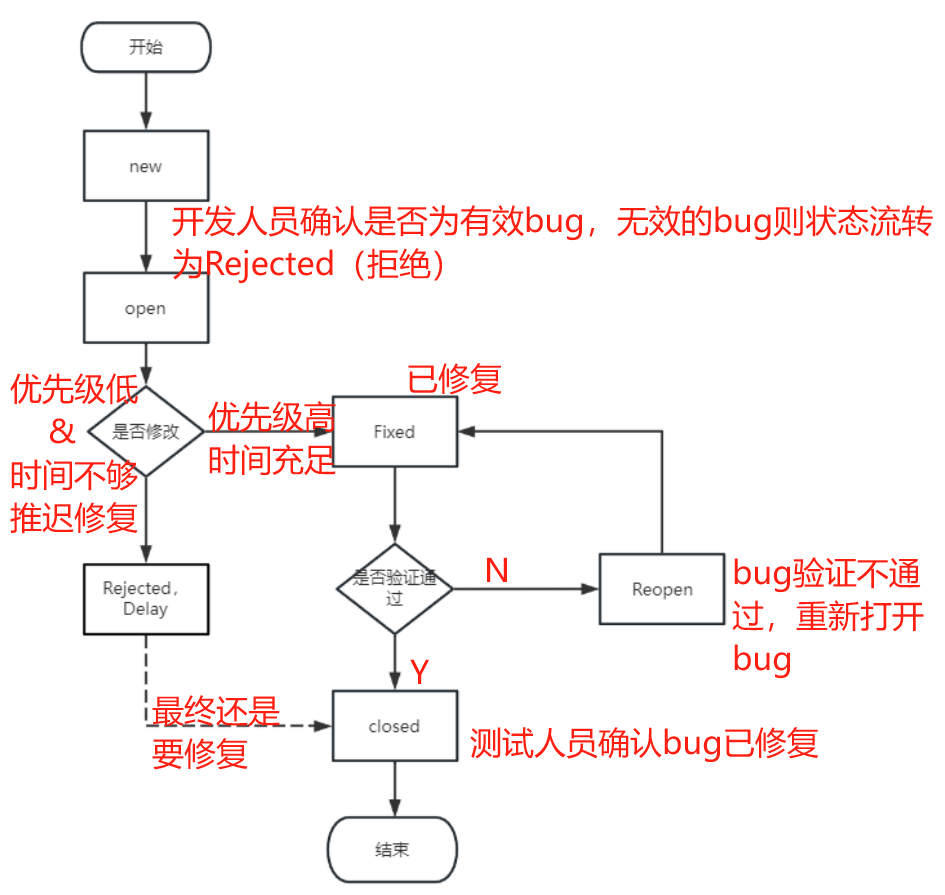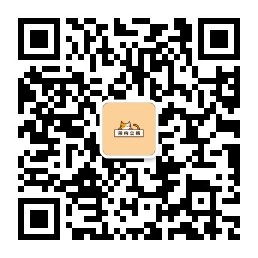JSONModel用法
基本用法
将传入的字典转换成模型:
首先定义模型类:
@interface Person : JSONModel
@property (nonatomic, copy) NSString *name;
@property (nonatomic, copy) NSString *sex;
@property (nonatomic, assign) NSInteger age;
@end接着使用字典来转换为模型:
NSDictionary *dict = @{@"name":@"Jack",@"age":@23,@"gender":@"male",};NSError *error;Person *person = [[Person alloc] initWithDictionary:dict error:&error];转换属性名称
有时候传入的字典的key名和J模型类的属性名称不匹配, 比如字典的key名被修改,从而导致异常,因此需要keyPapper方法来将模型中的属性转换成字典中对应的key名。
keyMapper方法需要返回一个字典,该字典的key是模型类的属性名称,value是传入的字典的key名
比如修改一下传入的字典里的gender字段为sex:
@implementation Person
+ (JSONKeyMapper *)keyMapper
{return [[JSONKeyMapper alloc] initWithModelToJSONDictionary:@{@"gender": @"sex", }];
}这样一来,JSONKeyMapper就会自动帮我们做转换
自定义错误
JSONModel框架的作者允许开发者自定义错误阻止模型的转换
使用validate方法
比如实现当age对应的数值小于18等待时候输出未成年,并阻止模型的转换:
- (BOOL)validate:(NSError **)error
{if (![super validate:error])return NO;if (self.age < 18){*error = [NSError errorWithDomain:@"未成年!" code:10 userInfo:nil];NSError *errorLog = *error;NSLog(@"%@",errorLog.domain);return NO;}return YES;
}模型嵌套
源码分析

在JSONMoodel中提供了四种初始化方法:
-(instancetype)initWithString:(NSString*)string error:(JSONModelError**)err;
-(instancetype)initWithString:(NSString *)string usingEncoding:(NSStringEncoding)encoding error:(JSONModelError**)err;
-(instancetype)initWithDictionary:(NSDictionary*)dict error:(NSError **)err;
-(instancetype)initWithData:(NSData *)data error:(NSError **)error;这些初始化方法最终都会调用initWithDictionary方法
-(instancetype)initWithData:(NSData *)data error:(NSError *__autoreleasing *)err
{//check for nil inputif (!data) {if (err) *err = [JSONModelError errorInputIsNil];return nil;}//read the jsonJSONModelError* initError = nil;id obj = [NSJSONSerialization JSONObjectWithData:dataoptions:kNilOptionserror:&initError];if (initError) {if (err) *err = [JSONModelError errorBadJSON];return nil;}//init with dictionaryid objModel = [self initWithDictionary:obj error:&initError];if (initError && err) *err = initError;return objModel;
}-(id)initWithString:(NSString*)string error:(JSONModelError**)err
{JSONModelError* initError = nil;id objModel = [self initWithString:string usingEncoding:NSUTF8StringEncoding error:&initError];if (initError && err) *err = initError;return objModel;
}-(id)initWithString:(NSString *)string usingEncoding:(NSStringEncoding)encoding error:(JSONModelError**)err
{//check for nil inputif (!string) {if (err) *err = [JSONModelError errorInputIsNil];return nil;}JSONModelError* initError = nil;id objModel = [self initWithData:[string dataUsingEncoding:encoding] error:&initError];if (initError && err) *err = initError;return objModel;}下面是initWithDictionary:的源码:
几个重要的点:
- 关联对象kClassPropertiesKey:(用来保存所有属性信息的NSDictionary)
- 关联对象kClassRequiredPropertyNamesKey:(用来保存所有属性的名称的NSSet)
- 关联对象kMapperObjectKey:(用来保存JSONKeyMapper):自定义的mapper,具体的方法就是用来自定义修改接受数据中的key
- JSONModelClassProperty:封装的jsonmodel的一个属性,它包含了对应属性的名字:(例如 name:gender),类型(例如 type:NSString),是否是JSONModel支持的类型(isStandardJSONType:YES/NO),是否是可变对象(isMutable:YES/NO)等属性。
整个执行流程: 首先,在这个模型类的对象被初始化的时候,遍历自身到所有的父类(直到JSONModel为止),获取所有的属性,并将其保存在一个字典里。获取传入字典的所有key,将这些key与保存的所有属性进行匹配。如果匹配成功,则进行kvc赋值。
initWithDictionary
//这个方法里包含了作者做到的所有的容错和模型转化-(id)initWithDictionary:(NSDictionary*)dict error:(NSError**)err
{//check for nil input//1.第一步判断传入的是否为nilif (!dict) {if (err) *err = [JSONModelError errorInputIsNil];return nil;}//invalid input, just create empty instance//2.第二步判断传入的是否为字典类型if (![dict isKindOfClass:[NSDictionary class]]) {if (err) *err = [JSONModelError errorInvalidDataWithMessage:@"Attempt to initialize JSONModel object using initWithDictionary:error: but the dictionary parameter was not an 'NSDictionary'."];return nil;}//create a class instance//3.创建类实例,通过init方法初始化映射propertyself = [self init];if (!self) {//super init didn't succeedif (err) *err = [JSONModelError errorModelIsInvalid];return nil;}//check incoming data structure//4.检查用户定义的模型里的属性集合是否大于传入的字典里的key集合(如果大于,则返回NO)就返回nil,并且抛出错误if (![self __doesDictionary:dict matchModelWithKeyMapper:self.__keyMapper error:err]) {return nil;}//import the data from a dictionary//5.根据传入的dict进行数据的赋值,如果赋值没有成功,就返回nil,并且抛出错误。if (![self __importDictionary:dict withKeyMapper:self.__keyMapper validation:YES error:err]) {return nil;}//run any custom model validation//6.根据本地的错误来判断是否有错误,如果有错误,就返回nil,并且抛出错误。if (![self validate:err]) {return nil;}//model is valid! yay!//7.前面的判断都通过,返回selfreturn self;
}- 判断传入的参数是否为空,如果为空直接返回nii
- 检查参数是否是NSDictonary的实例,如果不是返回nil
- 初始化JSONModel实例,设置Model1的属性集合
- 检查Model类的属性数目是否大于传入的的字典的key的数目,如果大于则返回NO
- 将传入的dict的值赋值给Model类的属性
- 如果重写了validate方法,则根据自定义的错误来阻拦model的返回
init
- (id)init
{self = [super init];if (self) {//do initial class setup[self __setup__];}return self;
}在该方法中调用了setup方法
setup
- (void)__setup__
{//if first instance of this model, generate the property list// 如果是该模型的第一个实例,则生成属性列表if (!objc_getAssociatedObject(self.class, &kClassPropertiesKey)) {[self __inspectProperties];}//if there's a custom key mapper, store it in the associated objectid mapper = [[self class] keyMapper];if ( mapper && !objc_getAssociatedObject(self.class, &kMapperObjectKey) ) {objc_setAssociatedObject(self.class,&kMapperObjectKey,mapper,OBJC_ASSOCIATION_RETAIN // This is atomic);}
}- 首先通过
objc_getAssociatedObject方法判断属性是否已经被缓存过,如果没有就调用inspectProperties方法将属性进行缓存 - 接着判断是否存在
keyMapper方法,如果有就将keyMapper与模型类进行关联
__inspectProperties
-(void)__inspectProperties
{
// 最终保存所有属性的字典,形式为:
// {
// age = "@property primitive age (Setters = [])";
// friends = "@property NSArray* friends (Standard JSON type, Setters = [])";
// gender = "@property NSString* gender (Standard JSON type, Setters = [])";
// name = "@property NSString* name (Standard JSON type, Setters = [])";
// }NSMutableDictionary* propertyIndex = [NSMutableDictionary dictionary];//获取当前的类名Class class = [self class]; NSScanner* scanner = nil;NSString* propertyType = nil;// 循环条件:当class 是 JSONModel自己的时候终止while (class != [JSONModel class]) { //属性的个数unsigned int propertyCount;//获得属性列表(所有@property声明的属性)objc_property_t *properties = class_copyPropertyList(class, &propertyCount);//遍历所有的属性for (unsigned int i = 0; i < propertyCount; i++) {//获得属性名称objc_property_t property = properties[i];//获得当前的属性const char *propertyName = property_getName(property);//name(C字符串) //JSONModel里的每一个属性,都被封装成一个JSONModelClassProperty对象JSONModelClassProperty* p = [[JSONModelClassProperty alloc] init];p.name = @(propertyName);//propertyName:属性名称,例如:name,age,gender//获得属性类型const char *attrs = property_getAttributes(property);NSString* propertyAttributes = @(attrs);// T@\"NSString\",C,N,V_name// Tq,N,V_age// T@\"NSString\",C,N,V_gender// T@"NSArray",&,N,V_friends NSArray* attributeItems = [propertyAttributes componentsSeparatedByString:@","];//说明是只读属性,不做任何操作if ([attributeItems containsObject:@"R"]) {continue; //to next property}//检查出是布尔值if ([propertyAttributes hasPrefix:@"Tc,"]) {p.structName = @"BOOL";//使其变为结构体} //实例化一个scannerscanner = [NSScanner scannerWithString: propertyAttributes];[scanner scanUpToString:@"T" intoString: nil];[scanner scanString:@"T" intoString:nil];//http://blog.csdn.net/kmyhy/article/details/8258858 if ([scanner scanString:@"@\"" intoString: &propertyType]) { //属性是一个对象[scanner scanUpToCharactersFromSet:[NSCharacterSet characterSetWithCharactersInString:@"\"<"]intoString:&propertyType];//propertyType -> NSString p.type = NSClassFromString(propertyType);// p.type = @"NSString"p.isMutable = ([propertyType rangeOfString:@"Mutable"].location != NSNotFound); //判断是否是可变的对象p.isStandardJSONType = [allowedJSONTypes containsObject:p.type];//是否是该框架兼容的类型//存在协议(数组,也就是嵌套模型)while ([scanner scanString:@"<" intoString:NULL]) {NSString* protocolName = nil;[scanner scanUpToString:@">" intoString: &protocolName];if ([protocolName isEqualToString:@"Optional"]) {p.isOptional = YES;} else if([protocolName isEqualToString:@"Index"]) {
#pragma GCC diagnostic push
#pragma GCC diagnostic ignored "-Wdeprecated-declarations"p.isIndex = YES;
#pragma GCC diagnostic popobjc_setAssociatedObject(self.class,&kIndexPropertyNameKey,p.name,OBJC_ASSOCIATION_RETAIN // This is atomic);} else if([protocolName isEqualToString:@"Ignore"]) {p = nil;} else {p.protocol = protocolName;}//到最接近的>为止[scanner scanString:@">" intoString:NULL];}} else if ([scanner scanString:@"{" intoString: &propertyType]) //属性是结构体[scanner scanCharactersFromSet:[NSCharacterSet alphanumericCharacterSet]intoString:&propertyType];p.isStandardJSONType = NO;p.structName = propertyType;}else {//属性是基本类型:Tq,N,V_age[scanner scanUpToCharactersFromSet:[NSCharacterSet characterSetWithCharactersInString:@","]intoString:&propertyType];//propertyType:qpropertyType = valueTransformer.primitivesNames[propertyType]; //propertyType:long//基本类型数组if (![allowedPrimitiveTypes containsObject:propertyType]) {//类型不支持@throw [NSException exceptionWithName:@"JSONModelProperty type not allowed"reason:[NSString stringWithFormat:@"Property type of %@.%@ is not supported by JSONModel.", self.class, p.name]userInfo:nil];}}NSString *nsPropertyName = @(propertyName); //可选的if([[self class] propertyIsOptional:nsPropertyName]){p.isOptional = YES;}//可忽略的if([[self class] propertyIsIgnored:nsPropertyName]){p = nil;}//集合类Class customClass = [[self class] classForCollectionProperty:nsPropertyName]; if (customClass) {p.protocol = NSStringFromClass(customClass);}//忽略blockif ([propertyType isEqualToString:@"Block"]) {p = nil;}//如果字典里不存在,则添加到属性字典里(终于添加上去了。。。)if (p && ![propertyIndex objectForKey:p.name]) {[propertyIndex setValue:p forKey:p.name];}//setter 和 getterif (p){ //name ->NameNSString *name = [p.name stringByReplacingCharactersInRange:NSMakeRange(0, 1) withString:[p.name substringToIndex:1].uppercaseString];// getterSEL getter = NSSelectorFromString([NSString stringWithFormat:@"JSONObjectFor%@", name]);if ([self respondsToSelector:getter])p.customGetter = getter;// settersp.customSetters = [NSMutableDictionary new];SEL genericSetter = NSSelectorFromString([NSString stringWithFormat:@"set%@WithJSONObject:", name]);if ([self respondsToSelector:genericSetter])p.customSetters[@"generic"] = [NSValue valueWithBytes:&genericSetter objCType:@encode(SEL)];for (Class type in allowedJSONTypes){NSString *class = NSStringFromClass([JSONValueTransformer classByResolvingClusterClasses:type]);if (p.customSetters[class])continue;SEL setter = NSSelectorFromString([NSString stringWithFormat:@"set%@With%@:", name, class]);if ([self respondsToSelector:setter])p.customSetters[class] = [NSValue valueWithBytes:&setter objCType:@encode(SEL)];}}}free(properties);//再指向自己的父类,知道等于JSONModel才停止class = [class superclass];}//最后保存所有当前类,JSONModel的所有的父类的属性objc_setAssociatedObject(self.class,&kClassPropertiesKey,[propertyIndex copy],OBJC_ASSOCIATION_RETAIN);
}- 首先进入循环,循环终止的条件是当前类是JSONModel类。
- 接着使用
class_copyPropertyList方法获取Model类的属性列表 - 然后为每个属性创建一个
JSONModelProperty对象 JSONModelProperty对象是创建的propertyIndex的value值JSONModelProperty对象中包含了属性名、数据类型、对应的 JSON 字段名等信息- 将当前类的指针指向其父类
- 最后所有的这些
JSONModelProperty对象都会存储在一个NSMutableDictionary对象——propertyIndex中,然后通过objc_setAssociatedObject与模型进行关联
这个方法用于检索JSONModel类中的属性,并将其转化为一个可用的 NSDictionary 对象。该方法会遍历模型类的属性,然后解析每个属性的相关信息(如属性名、数据类型、对应的 JSON 字段名等),并将其存储在 NSDictionary 对象中,也就是上文的propertyIndex
- (BOOL)__doesDictionary:(NSDictionary*)dict matchModelWithKeyMapper:(JSONKeyMapper*)keyMapper
//model类里面定义的属性集合是不能大于传入的字典里的key集合的。
//如果存在了用户自定义的mapper,则需要按照用户的定义来进行转换。
//(例如将gender转换为了sex)。
-(BOOL)__doesDictionary:(NSDictionary*)dict matchModelWithKeyMapper:(JSONKeyMapper*)keyMapper error:(NSError**)err
{//check if all required properties are present//拿到字典里所有的keyNSArray* incomingKeysArray = [dict allKeys];NSMutableSet* requiredProperties = [self __requiredPropertyNames].mutableCopy;//从array拿到setNSSet* incomingKeys = [NSSet setWithArray: incomingKeysArray];//transform the key names, if necessary//如有必要,变换键名称//如果用户自定义了mapper,则进行转换if (keyMapper || globalKeyMapper) {NSMutableSet* transformedIncomingKeys = [NSMutableSet setWithCapacity: requiredProperties.count];NSString* transformedName = nil;//loop over the required properties list//在所需属性列表上循环//遍历需要转换的属性列表for (JSONModelClassProperty* property in [self __properties__]) {//被转换成的属性名称(例如)TestModel(模型内) -> url(字典内)transformedName = (keyMapper||globalKeyMapper) ? [self __mapString:property.name withKeyMapper:keyMapper] : property.name;//check if exists and if so, add to incoming keys//检查是否存在,如果存在,则添加到传入密钥//(例如)拿到url以后,查看传入的字典里是否有url对应的值id value;@try {value = [dict valueForKeyPath:transformedName];}@catch (NSException *exception) {value = dict[transformedName];}if (value) {[transformedIncomingKeys addObject: property.name];}}//overwrite the raw incoming list with the mapped key names//用映射的键名称覆盖原始传入列表incomingKeys = transformedIncomingKeys;}//check for missing input keys//检查是否缺少输入键//查看当前的model的属性的集合是否大于传入的属性集合,如果是,则返回错误//也就是说模型类里的属性是不能多于传入字典里的key的,例如:if (![requiredProperties isSubsetOfSet:incomingKeys]) {//get a list of the missing properties//获取缺失属性的列表(获取多出来的属性)[requiredProperties minusSet:incomingKeys];//not all required properties are in - invalid input//并非所有必需的属性都在 in - 输入无效JMLog(@"Incoming data was invalid [%@ initWithDictionary:]. Keys missing: %@", self.class, requiredProperties);if (err) *err = [JSONModelError errorInvalidDataWithMissingKeys:requiredProperties];return NO;}//not needed anymore//不再需要了,释放掉incomingKeys= nil;requiredProperties= nil;return YES;
}- 首先获取dict中所有的key名传入数组incomingKeysArray中
- 接着获取Model类中所有的属性名传入集合equiredProperties中
- 将dict中得到的key数组转换为集合类型
- 如果存在keyMapper或者globalKeyMapper则将模型中的属性名转换为
KeyMapper中对应的Value,也就是将Model类中的属性名转换为Json数据key名 - 更新dict的键名集合,这样做是为了保证dict中的每个键名都有对应的有效值,而不是仅仅只有一个key键
- 检查Model类的属性数目是否大于传入的的字典的key的数目,如果大于则返回NO,因为此时JSON中的数据不能完全覆盖我们声明的属性
- (BOOL)__importDictionary:(NSDictionary*)dict withKeyMapper:(JSONKeyMapper*)keyMapper validation:(BOOL)validation error:(NSError**)err
使用kvc根据传入的dict进行数据的赋值,如果赋值没有成功,就返回nil,并且抛出错误。
//作者在最后给属性赋值的时候使用的是kvc的setValue:ForKey:的方法。
//作者判断了模型里的属性的类型是否是JSONModel的子类,可见作者的考虑是非常周全的。
//整个框架看下来,有很多的地方涉及到了错误判断,作者将将错误类型单独抽出一个类(JSONModelError),里面支持的错误类型很多,可以侧面反应作者思维之缜密。而且这个做法也可以在我们写自己的框架或者项目中使用。
//从字典里获取值并赋给当前模型对象
-(BOOL)__importDictionary:(NSDictionary*)dict withKeyMapper:(JSONKeyMapper*)keyMapper validation:(BOOL)validation error:(NSError**)err
{//loop over the incoming keys and set self's properties//遍历保存的所有属性的字典for (JSONModelClassProperty* property in [self __properties__]) {//convert key name to model keys, if a mapper is provided//将属性的名称(若有改动就拿改后的名称)拿过来,作为key,用这个key来查找传进来的字典里对应的值NSString* jsonKeyPath = (keyMapper||globalKeyMapper) ? [self __mapString:property.name withKeyMapper:keyMapper] : property.name;//JMLog(@"keyPath: %@", jsonKeyPath);//general check for data type compliance//用来保存从字典里获取的值id jsonValue;@try {jsonValue = [dict valueForKeyPath: jsonKeyPath];}@catch (NSException *exception) {jsonValue = dict[jsonKeyPath];}//check for Optional properties//检查可选属性//字典不存在对应的keyif (isNull(jsonValue)) {//skip this property, continue with next property//跳过此属性,继续下一个属性//如果这个key是可以不存在的if (property.isOptional || !validation) continue;//如果这个key是必须有的,则返回错误if (err) {//null value for required property//所需属性的值为nullNSString* msg = [NSString stringWithFormat:@"Value of required model key %@ is null", property.name];JSONModelError* dataErr = [JSONModelError errorInvalidDataWithMessage:msg];*err = [dataErr errorByPrependingKeyPathComponent:property.name];}return NO;}//获取,取到的值的类型Class jsonValueClass = [jsonValue class];BOOL isValueOfAllowedType = NO;//查看是否是本框架兼容的属性类型for (Class allowedType in allowedJSONTypes) {if ( [jsonValueClass isSubclassOfClass: allowedType] ) {isValueOfAllowedType = YES;break;}}//如果不兼容,则返回NO,mapping失败,抛出错误if (isValueOfAllowedType==NO) {//type not allowedJMLog(@"Type %@ is not allowed in JSON.", NSStringFromClass(jsonValueClass));if (err) {NSString* msg = [NSString stringWithFormat:@"Type %@ is not allowed in JSON.", NSStringFromClass(jsonValueClass)];JSONModelError* dataErr = [JSONModelError errorInvalidDataWithMessage:msg];*err = [dataErr errorByPrependingKeyPathComponent:property.name];}return NO;}//check if there's matching property in the model//检查模型中是否有匹配的属性//如果是兼容的类型:if (property) {// check for custom setter, than the model doesn't need to do any guessing// how to read the property's value from JSON//检查自定义setter,则模型不需要进行任何猜测(查看是否有自定义setter,并设置)//如何从JSON读取属性值if ([self __customSetValue:jsonValue forProperty:property]) {//skip to next JSON key//跳到下一个JSON键continue;};// 0) handle primitivesif (property.type == nil && property.structName==nil) {//generic setter//通用setter//kvc赋值if (jsonValue != [self valueForKey:property.name]) {[self setValue:jsonValue forKey: property.name];}//skip directly to the next key//直接跳到下一个键continue;}// 0.5) handle nils//如果传来的值是空,即使当前的属性对应的值不是空,也要将空值赋给它if (isNull(jsonValue)) {if ([self valueForKey:property.name] != nil) {[self setValue:nil forKey: property.name];}continue;}// 1) check if property is itself a JSONModel//检查属性本身是否是jsonmodel类型if ([self __isJSONModelSubClass:property.type]) {//initialize the property's model, store it//初始化属性的模型,并将其存储//通过自身的转模型方法,获取对应的值JSONModelError* initErr = nil;id value = [[property.type alloc] initWithDictionary: jsonValue error:&initErr];if (!value) {//skip this property, continue with next property//跳过此属性,继续下一个属性(如果该属性不是必须的,则略过)if (property.isOptional || !validation) continue;// Propagate the error, including the property name as the key-path component//传播错误,包括将属性名称作为密钥路径组件(如果该属性是必须的,则返回错误)if((err != nil) && (initErr != nil)){*err = [initErr errorByPrependingKeyPathComponent:property.name];}return NO;}//当前的属性值与value不同时,则赋值if (![value isEqual:[self valueForKey:property.name]]) {[self setValue:value forKey: property.name];}//for clarity, does the same without continue//为清楚起见,不继续执行相同操作continue;} else {// 2) check if there's a protocol to the property// ) might or not be the case there's a built in transform for it//2)检查是否有协议//)可能是,也可能不是,它有一个内置的转换if (property.protocol) {//JMLog(@"proto: %@", p.protocol);//转化为数组,这个数组就是例子中的friends属性jsonValue = [self __transform:jsonValue forProperty:property error:err];if (!jsonValue) {if ((err != nil) && (*err == nil)) {NSString* msg = [NSString stringWithFormat:@"Failed to transform value, but no error was set during transformation. (%@)", property];JSONModelError* dataErr = [JSONModelError errorInvalidDataWithMessage:msg];*err = [dataErr errorByPrependingKeyPathComponent:property.name];}return NO;}}// 3.1) handle matching standard JSON types//3.1)句柄匹配标准JSON类型//对象类型if (property.isStandardJSONType && [jsonValue isKindOfClass: property.type]) {//mutable properties//可变类型的属性if (property.isMutable) {jsonValue = [jsonValue mutableCopy];}//set the property value//为属性赋值if (![jsonValue isEqual:[self valueForKey:property.name]]) {[self setValue:jsonValue forKey: property.name];}continue;}// 3.3) handle values to transform//3.3)处理要转换的值//当前的值的类型与对应的属性的类型不一样的时候,需要查看用户是否自定义了转换器(例如从NSSet到NSArray转换:-(NSSet *)NSSetFromNSArray:(NSArray *)array)if ((![jsonValue isKindOfClass:property.type] && !isNull(jsonValue))||//the property is mutable//属性是可变的property.isMutable||//custom struct property//自定义结构属性property.structName) {// searched around the web how to do this better// but did not find any solution, maybe that's the best idea? (hardly)//在网上搜索如何更好地做到这一点//但是没有找到任何解决方案,也许这是最好的主意?(几乎没有)Class sourceClass = [JSONValueTransformer classByResolvingClusterClasses:[jsonValue class]];//JMLog(@"to type: [%@] from type: [%@] transformer: [%@]", p.type, sourceClass, selectorName);//build a method selector for the property and json object classes//为属性和json对象类构建方法选择器NSString* selectorName = [NSString stringWithFormat:@"%@From%@:",(property.structName? property.structName : property.type), //target namesourceClass]; //source nameSEL selector = NSSelectorFromString(selectorName);//check for custom transformer//查看自定义的转换器是否存在BOOL foundCustomTransformer = NO;if ([valueTransformer respondsToSelector:selector]) {foundCustomTransformer = YES;} else {//try for hidden custom transformer//尝试隐藏自定义转换器selectorName = [NSString stringWithFormat:@"__%@",selectorName];selector = NSSelectorFromString(selectorName);if ([valueTransformer respondsToSelector:selector]) {foundCustomTransformer = YES;}}//check if there's a transformer with that name//检查是否有同名变压器//如果存在自定义转换器,则进行转换if (foundCustomTransformer) {IMP imp = [valueTransformer methodForSelector:selector];id (*func)(id, SEL, id) = (void *)imp;jsonValue = func(valueTransformer, selector, jsonValue);if (![jsonValue isEqual:[self valueForKey:property.name]])[self setValue:jsonValue forKey:property.name];} else {//如果没有自定义转换器,返回错误if (err) {NSString* msg = [NSString stringWithFormat:@"%@ type not supported for %@.%@", property.type, [self class], property.name];JSONModelError* dataErr = [JSONModelError errorInvalidDataWithTypeMismatch:msg];*err = [dataErr errorByPrependingKeyPathComponent:property.name];}return NO;}} else {// 3.4) handle "all other" cases (if any)// 3.4) handle "all other" cases (if any)//3.4)处理“所有其他”情况(如有)if (![jsonValue isEqual:[self valueForKey:property.name]])[self setValue:jsonValue forKey:property.name];}}}}return YES;
}- 首先遍历模型类中的每个属性
- 接着从JSON数据中拿出真正对应property的value,进行value一系列的值判断
- value可用的情况下,就开始进行赋值,有setter方法的通过setter方法赋值,基础类型int,float等直接赋值
- 如果property又是一个JSONModel,就递归先将子Model进行整体解析。
- 如果包含protocol字段,则表明内部是一个array或者dictionary,并包含这个protocol字段的对象解析。
- 对于其他情况,应该是一种类型的转换,通过获取值类型和property类型,调用相应的转换方法进行赋值。
- 作者在最后给属性赋值的时候使用的是kvc的setValue:ForKey:的方法。
- 作者判断了模型里的属性的类型是否是JSONModel的子类
- 整个框架看下来,有很多的地方涉及到了错误判断,作者将将错误类型单独抽出一个类(JSONModelError),里面支持的错误类型很多,体现了作者思维的缜密。而且这个做法也可以在我们写自己的框架或者项目中使用
总结
通过获取Model类的属性列表,与传入的JSON数据自动匹配,同时还可以通过KeyMapper修改不相同的映射,如果模型类与JSON数据字段不匹配则会抛出错误(这里体现为Model中某些必须的属性没有在JSON数据中找到相应的映射),最后如果类型等都检查成功,则通过KVC将JSON数据中的value设置在Model类的对应的属性上
- Runtime中动态解析Model数据类型,可以实现自动匹配
- 已经解析过的Model1的属性列表会通过AssociatedObject进行缓存避免重复解析














![[vue2+axios]下载文件+文件下载为乱码](https://i-blog.csdnimg.cn/direct/6cd822979d7b4eba80f6ae62067bad6c.png)



